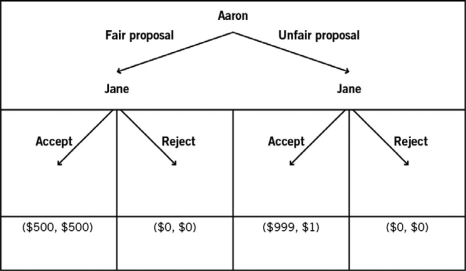Consider the accompanying decision tree and information to answer the questions that follow.
The decision tree depicts two players (Jane and Aaron) playing an ultimatum game where Aaron is given $1,000 and asked to propose a way of splitting it with Jane. When Jane learns Aaron's proposal, Jane chooses whether to accept or reject the split. If Jane accepts the split, both players receive the money according to Aaron's split proposal. If Jane rejects the split, both players receive nothing. This game will be played only once, so Aaron does not have to worry about reciprocity when making his choice.
There are four sets of payoffs at the terminal nodes of the decision tree. In each node, the dollar amount to the left of the comma represents Aaron's payoff, and the dollar amount to the right of the comma represents Jane's payoff.

-What is the likely outcome of the game if Aaron chooses to make a fair proposal?
Definitions:
Consumer Surplus
The difference between what consumers are willing to pay for a good or service and what they actually pay, representing the benefit to consumers.
Marginal Cost
The cost of producing one additional unit of a product or service.
Two-part Tariff
A pricing strategy that includes a fixed fee plus a variable charge based on usage or consumption of a product or service.
Marginal Cost
The expense associated with manufacturing an extra unit of a product.
Q1: Market activities that affect third-parties:<br>A) occur when
Q35: Beer prices at major league baseball stadiums
Q69: Which is a correct statement about a
Q84: More job opportunities open up in the
Q96: Economists consider both explicit and implicit costs
Q99: In 1980,the Schlitz Brewing Company conducted several
Q103: Economies of scale exist:<br>A) only for monopolists.<br>B)
Q130: When looking at a supply and demand
Q134: What would be the equilibrium price in
Q175: Three natural barriers to entry are:<br>A) patents